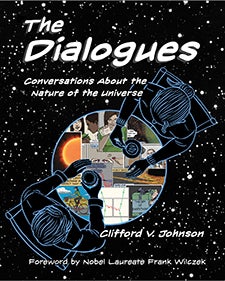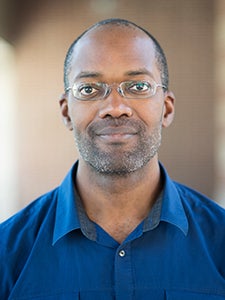
Five secrets from Clifford Johnson’s new graphic book on the science of the universe
Clifford Johnson’s motto is that science is not just for scientists.
So it’s no surprise that the professor of physics and astronomy, whose research focuses on the origin and makeup of the universe, has dedicated his time to bringing science to the masses. In addition to his teaching and research at USC Dornsife, Johnson is a science adviser to filmmakers and showrunners, helping them with their portrayal of scientific concepts and scientists in movies and television shows such as Thor: Ragnarok, Agent Carter and Genius. He also created the USC Science Film Competition in which interdisciplinary teams of students — including scientists, journalists and artists — create videos that explain a scientific idea for a non-expert audience.
On Nov. 17, Johnson’s new graphic book, The Dialogues: Conversations about the Nature of the Universe (The MIT Press), will hit stores, bringing his passion for conveying science to a general audience into print.
The Dialogues explains physics for everyday people, covering topics from black holes to the multiverse in a series of conversations. Not only did Johnson write the book, but he illustrated it as well — in a vivid comic-book style.
Here he shares a few of the secrets and behind-the-scenes facts about what went into creating The Dialogues.
1. The Dialogues has been nearly two decades in the making.
The seed for the idea of The Dialogues was planted 18 years ago.
“I remember it very clearly,” Johnson said. “I was in Manhattan in 1999 and I was just thinking, ‘Here’s a kind of book that doesn’t exist. If I were going to write a book, it would be a conversation about physics.’”
By 2006, he finally decided to make his idea a reality, taking his vision one step further by choosing to present those conversations in the format of a graphic novel.

The Dialogues presents physics concepts through a series of conversations between ordinary people.
2. The book includes more than a thousand illustrations, all drawn by Johnson himself.
Johnson used his 2010 spring semester sabbatical leave to figure out the answer to the question: Can I actually draw at the level required to create a full-length graphic novel?
“I figured the only way to find out was to just do it,” he said. “At that stage, I hadn’t told anyone what the idea was. I took my sabbatical and disappeared and didn’t tell anyone where I was or what I was doing.”
He spent those months studying the art of narrative storytelling and graphic novel production, which included hanging out and sketching in museums throughout Europe to perfect his drawing technique.
“I’ve always sketched a little bit, but there’s a whole other level of consistency and speed that you need to produce a 250-page book,” he said.
With up to 10 panels per page, and at least three versions of each drawing created during production, the final number of drawings for The Dialogues adds up to several thousand, created with a number of different media — pencil, ink, watercolor pencil and digital illustrations drawn on a tablet.
3. The conversation format of the narrative mirrors ancient Greek methods of explaining and understanding concepts.
The Dialogues presents physics concepts through a series of conversations between ordinary people. Johnson was inspired by the tradition of exploring complex ideas through dialogues, which dates back to ancient Greece.
The philosopher Plato wrote a series of works where his teacher Socrates explored universal questions from the nature of happiness to the meaning of integrity in conversations with other philosophers. Johnson found the format to be an exciting way to expand on topics like string theory, immortality, the nature of time, quantum gravity, and even cooking.

Clifford Johnson, professor of physics and astronomy at USC Dornsife. Photo by Peter Zhaoyu Zhou.
4. The Dialogues revealed a new equation to Johnson: Comics = Physics.
While working on the book project, Johnson came to a realization. In a graphic novel where sequential images build the narrative’s momentum, the reader is, in a sense, actively involved in creating time and space — the foundations of physics.
“I realized that, simply put, comics equals physics. In my opinion, that makes graphic books extremely appropriate for talking about the subject,” Johnson said.
In the book, he plays with that idea in different ways. In one scene, two characters discuss what may happen inside of a black hole where matter is compressed into an unimaginably tiny space. Space and time begin to act counterintuitively. The sequence of the discussion also begins to break the rules, so that the reader has to piece together the chronology for the scene, mirroring what may happen to space and time inside of a black hole.
5. The book is an invitation.
Above all, Johnson encourages everyone, whether they believe they have a predisposition for science or not, to have their own dialogues about science.
He explains: “The book is an invitation, or an example, encouraging people to say, ‘I can have conversations about science out there in the world, too.’ Also, conversations about science really do happen out there in the world. I know this. I hear them. I listen out for them. This book celebrates them.”
He also hopes that it will inspire other scientists to be creative in the ways that they disseminate science into the world.
“Science is for everybody, and my hope is to bring science back into our culture where it belongs,” he said.
Johnson explains why science belongs in mainstream culture.
Read more about The Dialogues in A physicist gets graphic about the nature of the universe and visit thedialoguesbook.com for additional behind-the-scenes peeks, event updates and more.